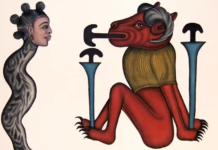NTOABOMA—The number of corrections and retractions in published news, especially in western media, is becoming more and more rampant. Worse, some argue that media in general is now a post-factual world: the hard facts have been replaced with the best stories. Stories full of lies. Like, Iraq had WMDs; like Gaddafi was about to commit genocide; like Americans landed on the Moon (until the original tapes were queried, and they miraculously disappeared from the archives)!
What is contributing to the emergence of this post-factual world? Surprise, suprise—an old tool. Or yet, an old method of lying. It is called Atokaka in Ntoaboma, and of late some power-full nations, with their media machinery to boot, wield it everywhere they go and anytime they open their wide mouths.
What is Atokaka? Before I tell you what it means, let me acquaint you with the origins of the word. In Ntoaboma, most folks speak either Twi or Ewe or both. (A significant few still speak some dialect of Guan). “Ato” comes from the word, “atosɛm,” which in Twi means “lies.” But that word, in particular, is actually not that unsophisticated. More, “atosɛm” refers to the stories that are told with the lies. That is, the narration of an “atosɛm” involves the concomitant fabrication of a tale in support of the lie.
In Ntoaboma tradition, for example, facts are not just facts, they are held in context. The context is what makes the fact the truth. For instance, you cannot say you landed on the Moon without the original tape. The tape (and because we believe original tapes tell truthful stories), which chronicled your landing, is the context of your claim—the fact. Since facts are not without context, so are lies. Those too are held in context. Lies are not mutually exclusive to their context either. Hence liars provide one. Good liars—which is an oxymoron since there’s nothing good about lying—always provide a palatable context.
The lie and the context is what we call in Ntoaboma, “atosɛm.” That is, “a lie of stories” or a “story full of lies.” This is different from the lie itself, which is “atoro.”
Now, we can appreciate where the “ato-” in Atokaka comes from. Let us examine the ending “-kaka.” Anyone with an elementary understanding of Ewe can quickly recognize that “kaka” means “to scatter [something] about [usually destroying it in the process].” If you’ve ever attempted to naturally drive out weevils from stored maize without spraying it with some variant of Monsanto’s DDT, that is, if you’ve ever tried drying out your wet-season’s worth of work the right way, on plantain leaves outside, in the Almighty Sun’s UV rays, in order to drive-out the weevils, you can appreciate what the Ewes mean when they say: “a flock of sheep just went through my maize and ‘kaka’ everything.” What they mean is that the maize that is now ‘scattered everywhere’ can no longer be retrieved, dusted and restored. Sheep, whose fleece can be as white as snow, however innocent they seem, can do a hell of damage to a person’s life-work. This meaning—of an irreversible destruction of a thing—is made more apparent when an Ewe person says some machine has “kaka.” It means the machine is no longer usable.
Thus, Atokaka means to scatter stories full of lies all about without the real intention to correct them now or in the future. The source(s) of the lie(s) could also be equally fleeced like innocent sheep, masquerading as angels. But in Atokaka, there’s no possibility of a full future correction of the lie. There’s no possibility of restoration. Atokaka is meant to destroy the thing that has become its focus. Atokaka are lies meant to permanently and irretrievably destroy a thing. And that my dear friends, makes Atokaka a powerful tool in any propaganda war.
The Ministry of Truth in the United States of America is innately aware of this method. In fact, in the Empire State of America, New York, there’s one cliché that captures the meaning of Atokaka. Imagine climbing to the top of the Empire State Building (1,454 feet above sea-level) and dicing open a pillow filled with feathers. Once someone, or an institution, or a group of institutions has employed Atokaka, placing a correction, or a God-forbidden retraction to the lies, is like trying to collect all those feathers back into the pillow, from the top of the building.
In other words, the multiple sources, or the reliable intelligence, which fed propaganda turds about Iraq, about Syria and about Libya to the Empire, and which that country’s Military Industrial Complex turned into its “boom-boom” scoop without even the most basic fact-checking, were some very experienced information manipulators who skillfully employed Atokaka.
Atokaka was employed by colonialists in Africa since 1492. It was employed by America’s most virulent enslavers to forge America’s industrial revolution. It was employed by imperialists and neo-imperialists, and it is also employed by and large by today’s white supremacist turds in the White “fleeced” House. What does Atokaka look like in the twenty-first century? The attacker argues a cause (with an ulterior motive of a military invasion) by hurling as many different half-truths and no-truths into a very short space of time so that his opponents—either because of a language barrier or mismatched methods—cannot hope to combat each point in real time.
Libya is now a pariah state, where the Old American South plantation-styled slavery has emerged with wings, because it was first defeated through Atokaka. USAFRICOM, an occupying American military force, is now everywhere present in Africa through Atokaka. Atokaka can only be defeated through matching the methods with facts, and producing these facts in real time with the same volume of context, at the least. For instance, every single time Atokakans claim they landed on the Moon, let’s say, “No, you are lying!” Until they can produce, in every instance (that is without ignoring any instance of the claim), the original tapes. If you allow them to lie about the Moon, they will soon lie about you and your humanity. Atokakans can destroy the truth permanently. But the power resides in your hands.











We all should turn our noses at Atokaka if we know what’s best for us. But the truth is Atokaka comes dressed up in textbooks and presented at universities and colleges. It is delivered by people who we highly respect. It’s tricky to spot. That’s why it’s so effective.
I agree with the above. I think the hard part is finding where to draw the line between stories of lies and truth. Is everything a lie? Yes probably from the Atokaka folk. Then the next question is: can you tell who is Ato and who is not? If it’s all lies then nobody can be trusted. I’m just not sure if that’s the way the world is or if thinking that is paranoid. I guess the whole point is to fuel distrust and let misinformation thrive. Great discussion to be had from this essay.
“Nobody in the world, nobody in history, has ever gotten their freedom by appealing to the moral sense of the people who were oppressing them.” ~ Assata Shakur. In the spirit of your essay, it is important to also understand and painfully accept the nature of our own oppression. And with that the nature of those who are doing the oppressing: they are evil and immoral. Failure to accept this is itself a lie, an Atokaka. And what is a worse lie than that against oneself! To commit Atokaka against one’s own being is the bottom of decadence, the height of stupidity. It is painful to see Africa’s elite commit Atokaka against their own nations in the the name of seeking “development aid” from their so-called partners in crime – the West.
Atokaka of Ayevuwo here, there and everywhere! So let us always insist upon our own Afrikan Truth here, there and everywhere!